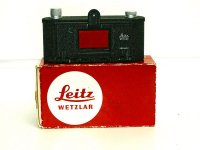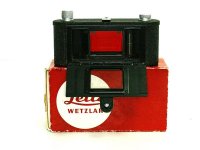Vickko
Mentor
I've got a couple questions.
Has anyone tried using an M8 (or a 4/3 micro camera, for that matter) as a slide/film digitizer?
I suppose in theory, it should work.
Questions:
- did Leica make a slide or film copier setup for the Visoflex? If so, what were the part numbers?
- did Leica make a slide or film copier setup for the Visoflex and bellows? If so, what were the part numbers?
- or would this be a silly option? The M8 would produce a 10 meg file, which I would think is pretty good for a scan.
- what about doing 6x9 cm? 4x5 inch? Is it just a matter of achieving the right setup? ie. light box, stand, correct M8/Visoflex/Bellows/lens combo?
....Vick
Has anyone tried using an M8 (or a 4/3 micro camera, for that matter) as a slide/film digitizer?
I suppose in theory, it should work.
Questions:
- did Leica make a slide or film copier setup for the Visoflex? If so, what were the part numbers?
- did Leica make a slide or film copier setup for the Visoflex and bellows? If so, what were the part numbers?
- or would this be a silly option? The M8 would produce a 10 meg file, which I would think is pretty good for a scan.
- what about doing 6x9 cm? 4x5 inch? Is it just a matter of achieving the right setup? ie. light box, stand, correct M8/Visoflex/Bellows/lens combo?
....Vick
jaapv
RFF Sponsoring Member.
Jamie123
Mentor
Probably more trouble than it's worth.
rxmd
May contain traces of nut
The idea is not new and not bad by itself, you can make lots of copies much faster than with a scanner.
Commercial slide copying units are problematic because of the crop factor. You need a lens with a different focal length, because you want a different enlargement ratio (1:1.3, in fact, or 1:2 for Micro 4/3).
The ELDIA is of course not suitable at all, because it's a contact copier for film-on-film copies that works without a camera.
In your case just put a bellows in front of it with a good 90mm enlarging lens, put the slide on a light table and experiment. Once you've got a good working distance and setup, think of how you can fix it for faster processing.
People have been building these things out of ordinary slide projectors - just projecting into the camera. This works, too, of course without a lens in the projector. It's a bit of a hack job but in the end you get a good 10mp slide digitizer. Your slides have to be clean, of course, and alignment has to be precise.
Commercial slide copying units are problematic because of the crop factor. You need a lens with a different focal length, because you want a different enlargement ratio (1:1.3, in fact, or 1:2 for Micro 4/3).
The ELDIA is of course not suitable at all, because it's a contact copier for film-on-film copies that works without a camera.
In your case just put a bellows in front of it with a good 90mm enlarging lens, put the slide on a light table and experiment. Once you've got a good working distance and setup, think of how you can fix it for faster processing.
People have been building these things out of ordinary slide projectors - just projecting into the camera. This works, too, of course without a lens in the projector. It's a bit of a hack job but in the end you get a good 10mp slide digitizer. Your slides have to be clean, of course, and alignment has to be precise.
borrel
Børre Ludvigsen
(I thought the ELDIA was a contact copy accessory mainly meant to make positive slides from B&W negative film.)
Using a digital camera (of sufficient resolution) is an excellent way of digitizing many slides relatively painlessly. These are my experiments with a 5D2 (http://abdallah.hiof.no/pb-4/), and I see no reason why an M8 shouldn't work with the right combination of bellows and lens. A Visoflex might help in focussing, but you're going to be adjusting critical focus off the camera's display anyway, so you might as well dispense with it unless it is necessary to make the lens - bellows combination work. For medium format you would need something more elaborate, but I have had good results with DIY light boxes for MF, sheet film and glass plates.
- Børre
Using a digital camera (of sufficient resolution) is an excellent way of digitizing many slides relatively painlessly. These are my experiments with a 5D2 (http://abdallah.hiof.no/pb-4/), and I see no reason why an M8 shouldn't work with the right combination of bellows and lens. A Visoflex might help in focussing, but you're going to be adjusting critical focus off the camera's display anyway, so you might as well dispense with it unless it is necessary to make the lens - bellows combination work. For medium format you would need something more elaborate, but I have had good results with DIY light boxes for MF, sheet film and glass plates.
- Børre
jaapv
RFF Sponsoring Member.
Yes- as I said, a film copier. The original use was to make contact prints for archival purposes but they were often used to copy slide film as you say.
rxmd
May contain traces of nut
Yes- as I said, a film copier. The original use was to make contact prints for archival purposes but they were often used to copy slide film as you say.
As far as I understood the original poster, he wants to digitize slides with a digital camera, not copy them?
A film copier is neat, but doesn't really address the question as I understood it.
jaapv
RFF Sponsoring Member.
- did Leica make a slide or film copier setup for the Visoflex? If so, what were the part numbers?
It is at least a part- answer..
shiro_kuro
Charles Bowen
Last edited:
artur5
Member
Muy 'setup' for the procedure consists of a Pentax M42 bellows +slide copier attachment, a 80/4 Rodagon enlarg. lens and a Canon 20D. All mounted on a tripod.
For lightning I use the remaining colorhead of a Durst enlarger ( located just behind the slide copier holder )
Using an enlarger Color head has the advantage that you can do a fine adjust of the WB with the dichroic filters.
It's way faster than any scanner, but you loose the I.C.E. feature for removing scratches/dust on color film. I think also than the dynamic range of a good dedicated scanner is better than my current camera. Surely a Canon 5DII would improve the results.
Another problem are the color negatives, How do you get rid off that annoying orange mask ?, Inverting the picture just gives a strongly blue tinted image. No way to get decent colors playing with color balances, curves, filters and all that ( I confess my poor skills with Photoshop ).
An additional question for the forum 'gurus' :
As I understand, all scanners -dedicated or flatbed- have 3 rows of photosites R-G-B ( maybe four. counting the IR.channel). The scanning is done three times successively for each image point, one for each color. So, they don't do interpolations like the Bayer algorithm of digital cameras, thus giving moire free images, Or I'm wrong ?
For lightning I use the remaining colorhead of a Durst enlarger ( located just behind the slide copier holder )
Using an enlarger Color head has the advantage that you can do a fine adjust of the WB with the dichroic filters.
It's way faster than any scanner, but you loose the I.C.E. feature for removing scratches/dust on color film. I think also than the dynamic range of a good dedicated scanner is better than my current camera. Surely a Canon 5DII would improve the results.
Another problem are the color negatives, How do you get rid off that annoying orange mask ?, Inverting the picture just gives a strongly blue tinted image. No way to get decent colors playing with color balances, curves, filters and all that ( I confess my poor skills with Photoshop ).
An additional question for the forum 'gurus' :
As I understand, all scanners -dedicated or flatbed- have 3 rows of photosites R-G-B ( maybe four. counting the IR.channel). The scanning is done three times successively for each image point, one for each color. So, they don't do interpolations like the Bayer algorithm of digital cameras, thus giving moire free images, Or I'm wrong ?
charjohncarter
Mentor
I use a slide copier(with DSLR), not with a Leica. It works:


Share:
-
This site uses cookies to help personalise content, tailor your experience and to keep you logged in if you register.
By continuing to use this site, you are consenting to our use of cookies.



